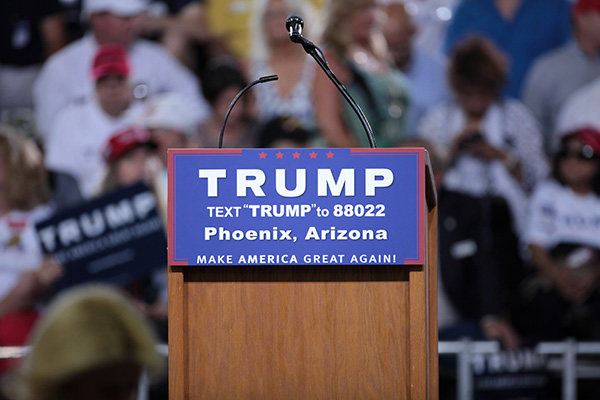
After experiencing a second surge in the polls during the latter half of October —driven by yet another intromission from the FBI regarding Clinton’s controversial email management while she was Secretary of State— Donald Trump’s candidacy had arrived nearly to the same point where he was at the end of his first surge during early September. Clinton’s lead had been reduced to 1.9pp by November 2 (in the RCP average of the polls) and the margin in the all-important Electoral College had shrunk to less than 40, with as many as 15 states remaining within the margin of error and therefore too close to call.
Nevertheless, over the course of the past week, Clinton has begun to climb in the national polls again, and as of the day before the election her lead in the popular vote now stands at over 3pp – although still within the margin of error. Indeed, the second Trump surge has already begun to recede in some states, although it has yet to show signs of breaking in others. However, the live betting odds have already recovered from the second Trump surge (which took Clinton’s edge down to only 70% probability) and now signal an 81% chance of a Clinton victory.
Still, the race is decided in the Electoral College as the collective result of each individual election at the state level. Here the election contest remains tight and still potentially volatile. According to the average of the individual state polls (as elaborated by RCP), Clinton maintains a lead of only 36 votes in the Electoral College. Furthermore, there are 15 states which are too close to call at the moment, given that the margin in favor on one candidate or the other remains very close to, or within, the polls’ margin of error (typically between 3% and 4%).
Most of these ‘battleground states’ are those which have recently experienced some kind of sociological or demographic shift, and which now are poised to possibly change their apparent long-term alignment. For example, Virginia and North Carolina have traditionally voted for the Republican presidential candidate; but due to influxes of both immigrants and the highly educated, these two states went for Obama in 2008 (and Virginia did again in 2012), and both are now ‘in play’ for Clinton. On the other hand, states like Michigan and Pennsylvania which have had a Democratic tendency, have both also been hotly contested, as ongoing de-industrialization has eliminated jobs. Although Clinton leads in both states, her margin has been shrinking in recent weeks, making these states – but particularly Pennsylvania, with its 20 electoral college votes — vulnerable to a Republican victory, especially with the mercurial Trump as the candidate. A similar shift is occurring in the Southwest, with Colorado, New Mexico, Nevada and even Arizona as similar demographic changes slowly make these states more structurally Democratic.
If Clinton were to win all of the swing states where she currently has the advantage, however small, and if Trump were to win all those states in play in which he currently has the advantage, then Clinton would just barely capture the 272 votes in the Electoral College required to be declared the winner. But this also means that if Trump were to win all of his current swing states, and also to also win just one that is currently in the hands of Clinton (like Pennsylvania) then Trump would become President. Therefore, tonight most eyes will be placed on the states of Florida, Ohio, Pennsylvania, North Carolina and even Michigan.
*
At a deeper level, however, the country enters the election visibly, tangibly, deeply divided. Demographic, economic, and technological trends (which are often dependent on each other) have conspired to polarize the country like no time since the American civil war (1861-1865). Each candidate (and party) is supported by distinct demographic groups: the majority of the racial minorities (Hispanics and black Americans), of women, of the educated and of the young all support Clinton; meanwhile, middle-aged white males and the less-educated are backing Trump. However, the most troubling tendency is that over the years – due to preferences and capacities, and pushed by economic and technological forces – these demographic groups have sorted themselves geographically, making such divides not just sociological and demographic but also increasingly regional.
When viewed state by state, as in the electoral map, this division of the country is dramatic: the coastal states increasingly support Democrats for president while the ‘heartland’ —the old South, the central Midwest, the Prairie States, the Great West and the North (ie, Idaho, Montana, Wyoming and the Dakotas)— increasingly tilts for Republicans. Meanwhile, the industrial northern Midwest (ie, Minnesota, Wisconsin, Michigan, Ohio and Pennsylvania), long considered to be a Democratic ‘firewall,’ is now at least partially in play, and under threat from Trump. Indeed, if the demographic and sociological divisions continue to sort themselves geographically following the same patterns of recent trends, a situation could soon be reached in which the Democrats control the coastal states (nearly completely from north to south), while the Republicans dominate across nearly the entire interior of the country. (For example, see the electoral map, by state, of the last election in 2012)
However, if the map is viewed at a more granular level – that is, by counties – the division of the country appears even more stark. From the county-level electoral map it becomes clear that the respective Democratic majorities are bulked in the cities (the largest of which are located along the coasts and the northern-eastern periphery) while the Republican majorities are present nearly everywhere else (in the smaller towns and countryside). Indeed, the geographic map concentrates the demographic strengths of each party: the coasts and most cities have majorities of racial minorities, young and well-educated whites; the heartland in turn has, particularly, the majorities of middle-aged, less educated white men. The division is not just between the coastal states and the interior land-locked states (which make up the majority of states), but really between the coastal cities and the interior —which includes the interiors of each coastal state as well). Indeed the only coastal state whose own rural interior does not boast clear Republican voting majorities is the state of New York.
Much of this sociological and demographic sorting has been driven by the open economy dynamics of globalization. Indeed, the economic destinies of these two geographic-demographic majorities have been very different under the globalization regime of the last 25 years. An early opening of the US economy had occurred in the 1970s with the trade liberalization of the Tokyo Round and the domestic liberalization of the economy under Reagan in the 80s; however, the end of the cold war, and the period of economic globalization which followed, progressively opened up most of the rest of the world economy to the penetration of American capital and exports, although it also allowed the goods of emerging economies, like China, to be able to compete in the US market.
This progressive opening to, and relative integration with, the global economy has favored the factors of production in the US (as economic theory predicts) that have become increasingly abundant in relative terms – that is, ‘economic and financial capital’ and ‘human capital’. These factors are increasingly concentrated in the coastal (or peripheral) cities. On the other hand, in the ‘heartland’ the most abundant local factor of production is unskilled labor —a factor of production which is not used intensively in the production of goods and services in which the US national economy has a comparative advantage (ie, those goods and services intensive in the country’s most abundant factor, capital and ‘human capital’, at least relative to labor, particularly unskilled).
None of this bodes well for the future, particularly if the kind of structural reforms and cohesion policies long pushed by the Democrats, but frontally block by an increasingly conservative Republican Party over the last 40 years, are now blocked again by large segments of the country that would actually benefit from a coherent policy of social cohesion, particularly in the face of global economic competition that will not go away. Of course, the current Republican candidate’s policy of trade protectionism is likely to be reciprocated by the world’s other major traders, damaging the economic prospect of the coasts and their cities, from where the bulk of our growing exports come.
Therefore, a deep challenge of national unity and cohesion will remain after the election, regardless of who wins in the end.


